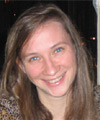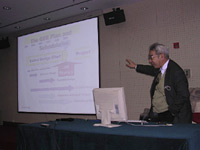 |
|
|
 |
Role of the LHC/ILC Study Group

Gudrid Moortgat-Pick |
Since spring 2002, a working group chaired by UK theorist Georg Weiglein (IPPP, Durham) has been working out how to strengthen the interplay between the LHC and the ILC and how the physics outcome of both machines can be optimized. “The combined studies carried out by the LHC/ILC Study Group open up a new kind of phenomenology”, said CERN theorist and member of the group Gudrid Moortgat-Pick. At the Large Hadron Collider, most of the collision processes will arise through the strong force and will produce strongly interacting particles which decay, for instance into electroweak particles. The latter particles will further decay, giving rise to a cascade. The masses of the involved particles can then be related to kinematical distributions of the decay cascade. The ILC, with its tuneable energy and its well-defined initial state, would give clear signatures of the electroweak events and would allow a very accurate study of the properties of the interacting particles. “If strategies for the interplay of the LHC and the ILC have been worked out, and if the physicists from both machines work on combined analyses, the physics results will be maximized”, said Moortgat-Pick.
Read more...
--Perrine Royole-Degieux |
 |
|
|
 |
|
Upcoming meetings, conferences, workshops
Area Systems Leaders Meeting
KEK
19-20 January, 2006
(Additional Info)
Control System Meeting: Feedback, Operations, High Availability (rtf)
SLAC
Contact: John Carwardine (carwar@anl.gov), Marc Ross, Phil Burrows
19-20 January 2006
Open Symposium on European Strategy for Particle Physics
LAL, Orsay, France
30 January-1 February 2006
ATF2 Project Meeting
SLAC
3-5 February 2006
LET Meeting
CERN
8-11 February 2006
LLRF Hardware Development Workshop (rtf)
FNAL
9-10 February, 2006
Area Systems Leaders Meeting
FNAL
13-14 February, 2006
EUDET Kick-Off Meeting
DESY
15-17 February 2006
LCWS 2006
Bangalore, India
9-13 March 2006
ILC GDE Meeting
Bangalore, India
9-11 March, 2006
International Symposium on Detector Development in Particle and Astroparticle Physics and Synchrotron Radiation
SLAC
April 3-6, 2006
International Accelerator School for Linear Colliders
Sokendai, Graduate School for Advanced Studies
Hayama, Japan
19-27 May 2006
ALCPG Meeting
Vancouver, Canada
19-23 July 2006
ILC GDE Meeting
Vancouver, Canada
19-23 July 2006 |
|
 |
 |
|
|
 |
Meeting in Beijing
After the Frascati meeting, Asian institutes started seeking ways to collaborate on ILC R&D towards Reference Design Report (RDR). About 30 researchers from Korea, China and Japan met at IHEP, Beijing on 16 January. Indian members were not able to attend, therefore this meeting was dubbed as "ILC-Beijing", not "ILC-Asia".
"The ILC-IHEP group was established with 28 members at the end of last year.", said Jie Gao, announcing the establishment of Chinese ILC R&D efforts. "We will produce 24 quadrupole magnets for ATF2, as well as the simulation studies for DR, designing cavities and editing the baseline configuration document (BCD)." The group will also produce prototype cavities and test them this summer. Gao says the members are also interested in a broad range of R&D activities, such as cryomodules, ML dynamics, bunch compressor, positron-source optimization. Tsinghua University, Peking University and Shanghai Light Source also expressed their interests in the ILC. Tsinghua University will soon start to collaborate on cavity R&D with KEK.
 |
Hitoshi Hayano and Jinhyuk Choi reported the ongoing accelerator R&D activities in Japan and Korea respectively. Shin-ichi Korukawa reported as chairs of ILCSC and ACFA on how ILC should be a truly international project, and how it will bring big chances for the Asian countries. The minutes of this meeting will be reported to Bill Willis, the chair of the RDB, global R&D board.
--Youhei Morita
|
 |
|
|
 |
From The Scotsman
13 January 2006
Dark discovery sheds light on the universe
A BRITISH-LED team of astronomers may have discovered the first invisible galaxy without stars and held together by a mystery force.
Scientists have suspected the existence of "dark galaxies" - areas in the universe containing a large amount of mass that rotates like galaxies, but with no stars - for years.
But the mystery VIRGOH121 galaxy, 50 million miles away, is the first to tick all the boxes needed to prove the theory.
Read more...
From Futura Sciences
13 January 2006
La saga des particules
"La physique des particules cherche à décrire la matière à l'échelle microscopique à partir d'un petit nombre de constituants élémentaires et de trois interactions fondamentales. Ce sont les fulgurants progrès accomplis au début du vingtième siècle par les recherches sur la structure de l'atome qui ont conduit à l'émergence de cette discipline. (...) Les perspectives futures termineront ce tour d'horizon."
Read more... |
|
 |
 |
|
|
 |
InDiCo - Integrated Digital Conferencing
One of the biggest challenges for our dispersed GDE effort is communications! This was apparent from the beginning and, as a result, I have continually emphasized the need for us to employ the most advanced electronic communications and web tools. I created a committee to study Electronic Document Management Systems (or alternately, Engineering Design Management Systems) called EDMS systems and to recommend what tools the GDE should adopted to support our design, documentation and archiving needs. The EDMS committee consists of Tom Markiewicz (SLAC) chair, John Ferguson (CERN), Lars Hagge (DESY), Rich Stanek (Fermilab), Nobu Toge (KEK) and Harry Weerts (Argonne).
The committee has recently made its first recommendations, which is for us to adopt the CERN InDiCo system for organizing our meetings, calendars and related materials. This recommendation was made to the GDE at the Frascati meeting in December and then was presented last week to the GDE Executive Committee. The Executive Committee accepted this recommendation and we will now begin the process of working with CERN and organizing our own efforts to implement InDiCo, hopefully in time to be used for the Bangalore meeting. The remaining questions of what to adopt for the GDE EDMS system are still being investigated by the committee.
The CERN Document Server (CDS) team, using the framework of the EU Integrated Digital Conferencing (InDiCo) project, has developed a new Web application for organizing conferences. This Web application has tools that allow users to schedule conferences, from single talks to complex meetings that have multiple sessions and contributions. The original InDiCo project was supported by the European Commission to respond to the challenges posed by the management of electronic documents, including the handling of multimedia content for the scientific meetings. The partnership for this project consisted of SISSA (Trieste, Italy), Udine University (Udine, Italy), TNO (Netherlands), University of Amsterdam (Netherlands) and CERN.
InDiCo is distributed under the GNU General Public License and is fully open source. Technically, it runs on an Apache web application server using the Python module and uses the Zope Object Database to store conference metadata. It is designed to manage all components of a meeting or conference including the program, attendance, material submission, electronic proceedings and archiving.
Read more...
--Barry Barish
Director's Corner Archive
|
 |
|
|
 |
RSS Feed Now Available for NewsLine
Read More
ILC Related Preprints
hep-ph/0601122
16 Jan 2006
Electroweak Corrections to e+ e- --> 4 fermions
physics/0601103
15 Jan 2006
The International Linear Collider beam dumps
hep-ph/0601112
13 Jan 2006
Report of the 2005 Snowmass Top/QCD Working Group
hep-ph/0601102
12 Jan 2006
On signatures for the Littlest Higgs model in electron-positron colliders
physics/0601069
11 Jan 2006
Modular Implementation of Particle Flow Algorithm with Minimized Dependence on the Detector Geometry
|
|

